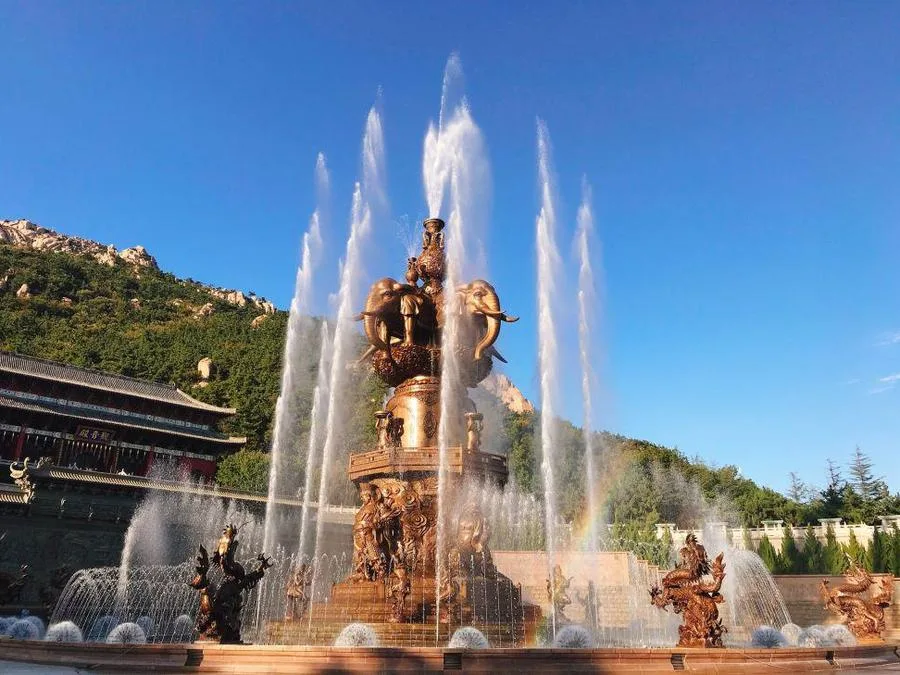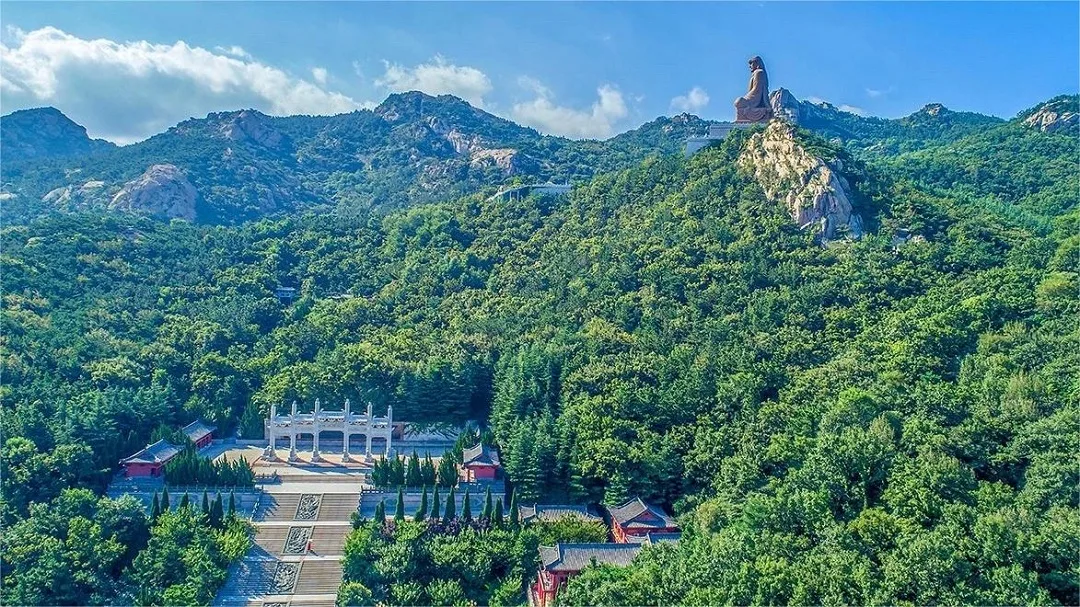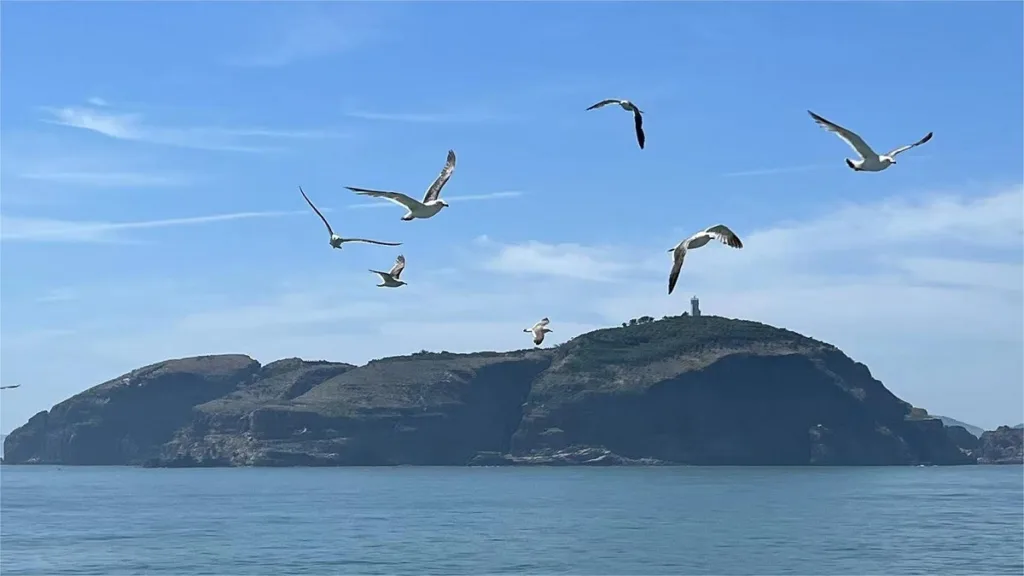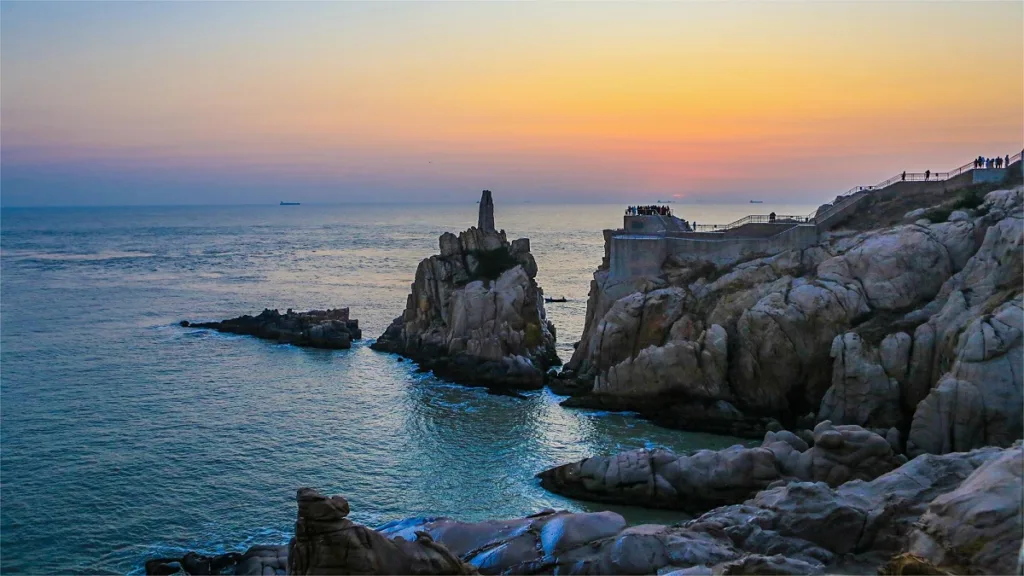Shidao Chishan Scenic Area (石岛赤山风景区, Stone Island Red Mountain Scenic Area), located in Rongcheng City, Shandong Province, covers an area of 12.8 square kilometers and is renowned for its red stones from which it derives its name. This scenic area boasts ten stunning attractions that complement each other, offering breathtaking beauty. Highlights include the ancient Buddhist temple with a millennium of history, Chishan Fahua Temple; the dynamic and world-renowned music fountain plaza, Jixiang Ping’an Valley; the iconic sea god statue, Chishan Daming Shen; and the memorial site of Korean maritime envoy Zhang Baozao, Zhang Baozao Biography Museum.
Visitors can also explore the Northern Chinese folk culture exhibition at Rongcheng Folk Museum, delve into the fascinating world of water and stone at the Shilan Ya Stone Museum, and enjoy the serene surroundings of Tianmen Tan Forest Park. For leisure and relaxation, the area features the International Seaside Bathing Beach and the tranquil Phoenix Lake Tourism Resort, making it a haven for coastal scenery tours, fishing culture experiences, religious pilgrimages, and a variety of cultural explorations.
Table of Contents
- Basic Information
- Location and Transportation
- Highlights of Shidao Chishan Scenic Area
- Other Attractions in Rongcheng
Basic Information
| Estimated Length of Tour | Over 3 hours |
| Ticket Price | 135 RMB |
| Opening Hours | 7.30 – 17.00 |
| Telephone Number | 0086-0631-7326666 |
Location and Transportation
Located at the easternmost tip of the Shandong Peninsula in China, Shidao Chishan Scenic Area is situated in Shidao, Rongcheng City, Weihai, Shandong Province. The scenic area is located on the outskirts of Rongcheng City. There are tourist shuttle buses available: from Rongcheng to Shidao (7 RMB per person) and from the Development Zone to Shidao (1 RMB per person), with buses departing every 2 minutes.
Highlights of Shidao Chishan Scenic Area
Fahua Temple

Fahua Temple, one of the earliest Buddhist temples in the Jiaodong Peninsula, dates back to 824 AD, founded by Zhang Baozao from the Silla Kingdom. Originally affiliated with the Tiantai sect of Buddhism, the temple is named after the Lotus Sutra (Fahua Jing) that was recited there. The temple was rebuilt in 1988 and officially reopened on May 1, 1989. It comprises several halls including the Mahavira Hall, Dizang Hall, Guanyin Hall, and Sakyamuni Hall, nestled amidst lush greenery and surrounded by picturesque mountains. Throughout the year, the temple is enveloped in mist and incense, offering a serene atmosphere for worship and contemplation.
Jixiang Ping’an Valley

Jixiang Ping’an Valley is a modern marvel combining sculpture, music, fountains, waterfalls, and fireworks to showcase dynamic Buddhist culture. This scenic area features a dynamic music fountain plaza where high-tech displays narrate ancient Buddhist stories. The centerpiece is a water curtain that surrounds and enhances the majestic setting, with four elephant sculptures guarding a vessel of peace and prosperity. During the impressive musical performance, synchronized with the grandeur of Buddhist chants, the fountain transforms into 13 unique water patterns. Four celestial beings rotate around the vessel, symbolizing blessings and abundance, while four guardian warriors emit colorful flames. Nearby, nine golden dragons breathe water columns, creating a spectacle of rainbows refracted through the fountain’s mist under the sunlight.
Chishan Zen Temple

Located west of Fahua Temple, Chishan Zen Temple is comprised of two main sections: Yuanren Hall and Chishan Pavilion, covering an area of 16,000 square meters with over 3,000 square meters of built space. Yuanren Hall features five exhibition halls – “Admiration for Buddhism,” “Navigating the Sea of Suffering,” “Master Cijue,” “Pilgrimage for the Dharma,” and “Accomplishing Success” – which showcase the history of Buddhist development during the Sui and Tang dynasties, Master Yuanren’s journey to Tang China to seek the Dharma, and his subsequent establishment of Chishan Zen Temple upon returning to Japan. Chishan Pavilion, spread across three floors, displays profound Buddhist culture: the first floor features statues and murals of Shakyamuni Buddha, the second floor houses the statue of Jianzhen, and the third floor is dedicated to Avalokitesvara Bodhisattva. Perched majestically against the mountains, the temple complex exudes solemnity with its pavilions, towers, and lush surroundings, creating a grand and spectacular atmosphere.
Tianhou Palace

Situated in the downtown area of Shidao, Tianhou Palace was originally built in the 16th year of the Qing Dynasty’s Qianlong reign (1752). Facing north and spanning three courtyards, the temple complex covers 1,400 square meters and includes Tianhou Palace, Daoist Temple, Fire God Temple, and Chamber of Commerce building, totaling 48 halls and pavilions. The architecture is elegant and refined, featuring intricate structures and a well-organized layout. Inside the palace, a white marble carved statue of Tianhou Niangniang gently holds a bright lamp in her right hand, her face exuding kindness and serenity as she watches over sailors and fishermen, blessing them with safe voyages and prosperity. Tianhou Palace embodies a fusion of Daoist, Buddhist, and Confucian cultures, housing halls dedicated to Guanyin Bodhisattva, Queen Mother of the West, God of Wealth, and Dragon King. Annually during the Grain Rain Festival, a grand temple fair is held where Daoist monks and Buddhist nuns gather to chant scriptures, praying for favorable weather and abundant harvests under Tianhou Niangniang’s divine protection.
Chishan Ming Shen Statue

Standing at an impressive height of 58.8 meters, Chishan Ming Shen is the world’s largest forged copper deity and China’s foremost sea god statue. Perched majestically overlooking the sea and land, Chishan Ming Shen, also known as Chishan Shen, is believed to originate from the Red Gate Cave of Chishan. Revered for its protective powers and boundless divine influence, Chishan Ming Shen safeguards the region and blesses all with prosperity and infinite merit, making it a revered deity in northern China.
Legend has it that during Emperor Qin Shi Huang’s eastern tour in 219 BC to seek the elixir of immortality, he fell gravely ill but recovered miraculously after prayers to Ming Shen by his minister Li Si. Centuries later, during the Tang Dynasty, the Japanese Tendai Buddhist monk Saicho (known as Ennin in Japanese) made several pilgrimages to Chishan to seek teachings, encountering numerous perils at sea which were miraculously averted by Ming Shen’s intervention.
This legacy has led to Chishan Ming Shen’s revered status in Japan, Korea, and beyond, with temples dedicated to its worship in various countries, continuing to bless humanity and offer spiritual solace.





